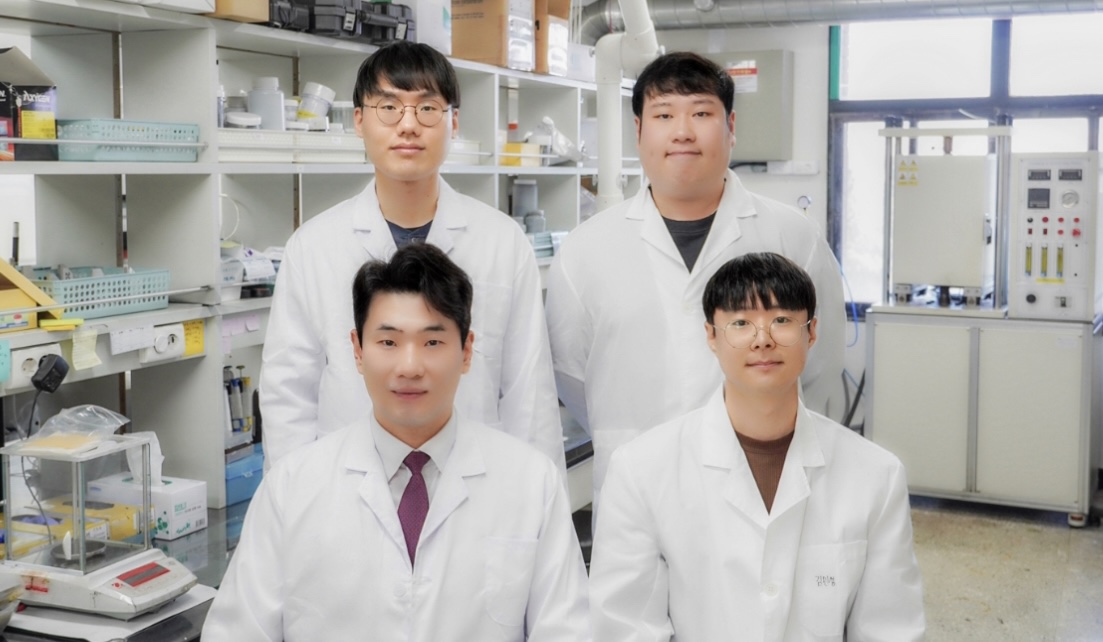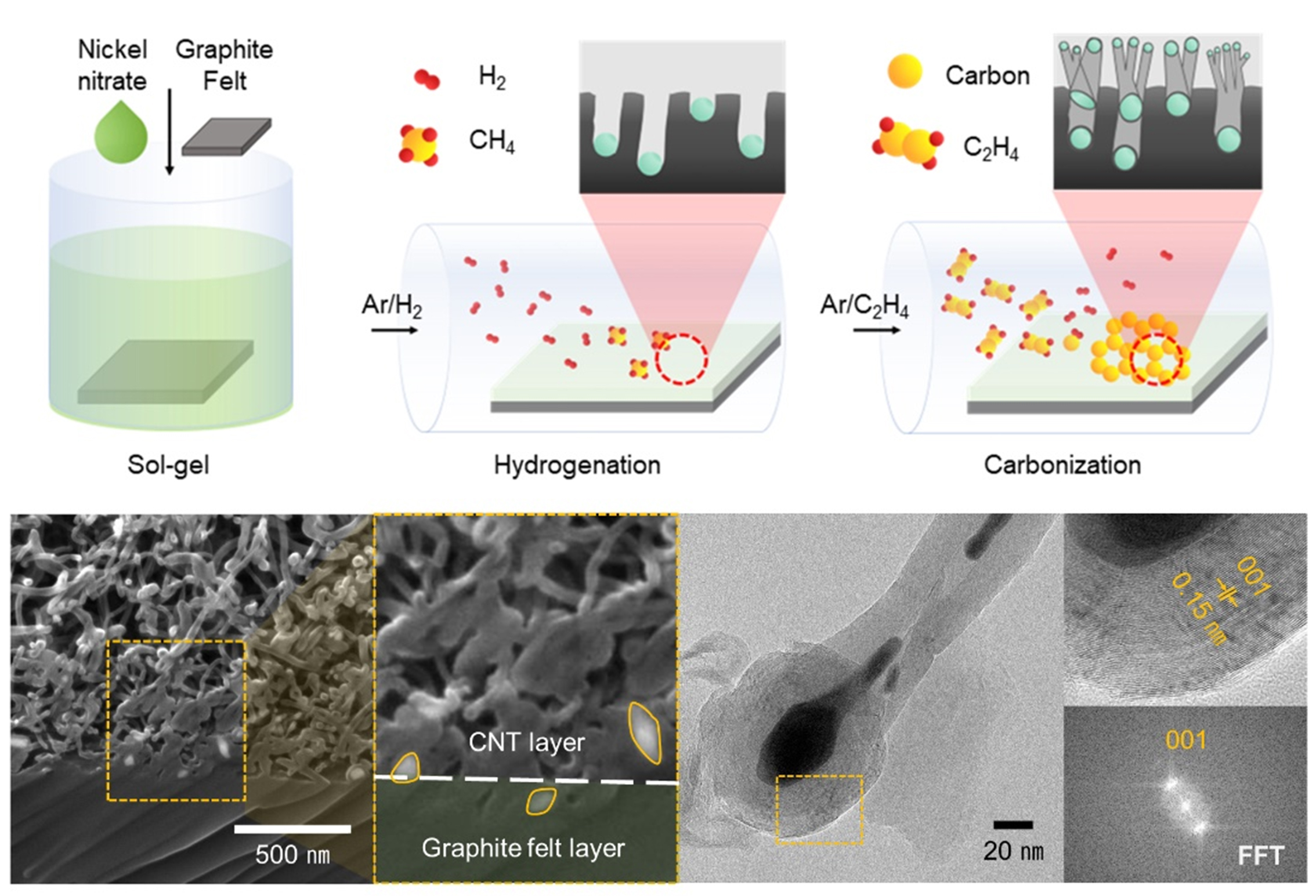커뮤니티
부경투데이
- 국립 부경대학교의 다양한 모습과 소식을 접하시면 부경대학교가 한번 더 가까워집니다.
| 이차전지 미래 연다 | 고민성 교수 연구팀(Paving the way to future secondary batteries | the research team of prof. Ko Min-Seong) | |||
| 작성자 | 대외협력과 | 작성일 | 2023-03-30 |
| 조회수 | 580 | ||
| 이차전지 미래 연다 | 고민성 교수 연구팀(Paving the way to future secondary batteries | the research team of prof. Ko Min-Seong) | |||||
 |
대외협력과 |  |
2023-03-30 |  |
580 |
이차전지 전극 촉매에 ‘식물 뿌리 디자인’ 적용하니 용량·효율 ‘쑥’
- 부경대 고민성 교수팀, 고 내구성 흑연 전극 촉매 개발 … 국제학술지 논문 게재

△고민성 교수(왼쪽 아래)와 연구팀 사진.
차세대 이차전지용 전극의 촉매에 ‘식물 뿌리 디자인 전략’을 적용해 높은 내구성을 확보한 연구 결과가 나와 관심을 끈다.
국립부경대학교 고민성 교수(금속공학전공) 연구팀은 미국 로렌스 버클리 국립연구소(Lawrence Berkeley National Laboratory) 장해성 박사와 탄소나노튜브(Carbon nanotube)를 활용한 고 내구성의 흑연 전극 촉매 개발에 성공했다고 밝혔다.
최근 화재 위험성이 없는 수계 에너지저장장치 ‘바나듐 레독스 흐름전지’가 차세대 이차전지로 주목받고 있는데, 이 전지의 고수명·고용량 확보를 위한 설계 연구가 주요 관심사다.
바나듐 레독스 흐름전지는 높은 에너지 밀도를 달성하기 위해 비싼 귀금속이나 전이금속 산화물 등을 전극 촉매로 활용하는데, 산 전해액 유동에 의한 지속적인 마찰 때문에 전극 표면과 촉매 물질에 부식 및 손상이 발생하는 문제가 있다.
고민성 교수 연구팀은 이 같은 문제를 해결하기 위해 전극 촉매에 식물 뿌리 디자인 전략을 적용했다. 식물 뿌리가 땅에 단단히 박혀 있는 것처럼, 탄소나노튜브를 흑연 전극 내부의 카본 지지체에 심는 합성 공정을 제시한 것.
연구팀은 흑연 전극과 니켈 촉매 사이의 환원을 이용해 니켈 나노 입자가 전극 내부로 파고들도록 하고, 탄화수소 가스를 활용해 전극 내부에서부터 탄소나노튜브가 성장하도록 유도했다.
연구팀이 개발한 탄소나노튜브 촉매 적용 복합전극은 레독스 흐름 전지 특유의 산성 전해액 환경과 전해액의 유동으로부터 높은 내구성을 확인했다. 촉매가 식물 뿌리처럼 견고하게 지지 되면서 화학반응이 원활해진 것이다.
실험 결과 이 전극은 기존 흑연 전극 대비 용량성능이 40%(전류밀도 조건= 50 mA·cm-2) 향상됐고, 86.9%의 높은 에너지 효율을 달성한 것으로 나타났다.
고민성 교수는 “식물 뿌리와 같은 디자인은 화학기상증착(Chemical Vapor Deposition) 방식을 활용하면 비교적 쉽게 합성할 수 있어 바나듐을 제외한 다양한 수계 흐름 전지에도 안정적으로 적용이 가능할 것으로 기대한다.”라고 말했다.
한국연구재단의 지원을 받은 이번 연구는 탄소 재료 분야의 국제학술지인 <카본Carbon)>(IF=11.307)에 최근 게재됐다. <부경투데이>

△식물 뿌리와 같은 흑연 전극 합성 모식도.
By applying the ‘plant root-design’ to electrode catalyst of the secondary battery, both capacity and efficiency jumped-up
- a team led by prof. Ko Min-Seong at PKNU developed a graphite electrode catalyst with high durability … his paper published in international journals
A study that secured high durability by applying the ‘plant root-design strategy’ to catalysts for next-generation secondary battery electrodes is attracting attention from the academic world.
Professor Ko Min-Seong (metallurgical engineering) at Pukyong National University said that the research team, along with dr. Jang Hae-Seong at Lawrence berkeley national laboratory in the US, succeeded in developing a highly durable graphite electrode catalyst using carbon nanotubes.
While ‘vanadium redox flow battery’, a water-based energy storage device with no risk of fire, is attracting attention as a next-generation secondary battery, design research to secure long lifespan and high capacity of this battery is a major concern in the academic world.
Vanadium redox flow batteries use expensive noble metals or transition metal oxides as electrode catalysts to achieve high energy density, however, corrosion and damage to the electrode surfaces and catalyst materials may occur due to continuous friction caused by the flow of acid electrolyte.
To solve this problem, the research team of professor Ko applied a plant root design to electrode catalysts. The research team proposed a synthesis process in which carbon nanotubes are planted in the carbon support inside the graphite electrode, as if plant roots deeply rooted in the ground.
The research team used reduction between the graphite electrode and the nickel catalyst to allow nickel nanoparticles to penetrate the electrode, and induced carbon nanotubes to grow from the inside of the electrode using hydrocarbon gas.
The composite electrode developed by the research team, which applied carbon nanotubes as catalysts, has been confirmed to have high durability against the flow of electrolyte and the acidic electrolyte environment unique to redox flow batteries. As the catalyst is firmly supported like a plant root, it makes good progress in the chemical reaction.
As a result of the experiment, this electrode showed a 40% improvement in capacity performance compared to the existing graphite electrode (current density = 50 mA·cm-2) and a high energy efficiency of 86.9%.
Professor Ko said, “Designs such as plant roots can be synthesized easily using the chemical vapor deposition method, I expect that they can be stably applied to various water-based flow batteries except for vanadium.”
His research, supported by the National research foundation of Korea, was recently published in <Carbon>(IF=11.307), an international academic journal in the field of carbon materials. <Pukyong Today>